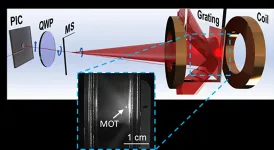(Press-News.org) It's cool to be small. Scientists at the National Institute of Standards and Technology (NIST) have miniaturized the optical components required to cool atoms down to a few thousandths of a degree above absolute zero, the first step in employing them on microchips to drive a new generation of super-accurate atomic clocks, enable navigation without GPS, and simulate quantum systems.
Cooling atoms is equivalent to slowing them down, which makes them a lot easier to study. At room temperature, atoms whiz through the air at nearly the speed of sound, some 343 meters per second. The rapid, randomly moving atoms have only fleeting interactions with other particles, and their motion can make it difficult to measure transitions between atomic energy levels. When atoms slow to a crawl -- about 0.1 meters per second -- researchers can measure the particles' energy transitions and other quantum properties accurately enough to use as reference standards in a myriad of navigation and other devices.
For more than two decades, scientists have cooled atoms by bombarding them with laser light, a feat for which NIST physicist Bill Phillips shared the 1997 Nobel Prize in physics. Although laser light would ordinarily energize atoms, causing them to move faster, if the frequency and other properties of the light are chosen carefully, the opposite happens. Upon striking the atoms, the laser photons reduce the atoms' momentum until they are moving slowly enough to be trapped by a magnetic field.
But to prepare the laser light so that it has the properties to cool atoms typically requires an optical assembly as big as a dining-room table. That's a problem because it limits the use of these ultracold atoms outside the laboratory, where they could become a key element of highly accurate navigation sensors, magnetometers and quantum simulations.
Now NIST researcher William McGehee and his colleagues have devised a compact optical platform, only about 15 centimeters (5.9 inches) long, that cools and traps gaseous atoms in a 1-centimeter-wide region. Although other miniature cooling systems have been built, this is the first one that relies solely on flat, or planar, optics, which are easy to mass produce.
"This is important as it demonstrates a pathway for making real devices and not just small versions of laboratory experiments," said McGehee. The new optical system, while still about 10 times too big to fit on a microchip, is a key step toward employing ultracold atoms in a host of compact, chip-based navigation and quantum devices outside a laboratory setting. Researchers from the Joint Quantum Institute, a collaboration between NIST and the University of Maryland in College Park, along with scientists from the University of Maryland's Institute for Research in Electronics and Applied Physics, also contributed to the study.
The apparatus, described online in the New Journal of Physics, consists of three optical elements. First, light is launched from an optical integrated circuit using a device called an extreme mode converter. The converter enlarges the narrow laser beam, initially about 500 nanometers (nm) in diameter (about five thousandths the thickness of a human hair), to 280 times that width. The enlarged beam then strikes a carefully engineered, ultrathin film known as a "metasurface" that's studded with tiny pillars, about 600 nm in length and 100 nm wide.
The nanopillars act to further widen the laser beam by another factor of 100. The dramatic widening is necessary for the beam to efficiently interact with and cool a large collection of atoms. Moreover, by accomplishing that feat within a small region of space, the metasurface miniaturizes the cooling process.
The metasurface reshapes the light in two other important ways, simultaneously altering the intensity and polarization (direction of vibration) of the light waves. Ordinarily, the intensity follows a bell-shaped curve, in which the light is brightest at the center of the beam, with a gradual falloff on either side. The NIST researchers designed the nanopillars so that the tiny structures modify the intensity, creating a beam that has a uniform brightness across its entire width. The uniform brightness allows more efficient use of the available light. Polarization of the light is also critical for laser cooling.
The expanding, reshaped beam then strikes a diffraction grating that splits the single beam into three pairs of equal and oppositely directed beams. Combined with an applied magnetic field, the four beams, pushing on the atoms in opposing directions, serve to trap the cooled atoms.
Each component of the optical system -- the converter, the metasurface and the grating -- had been developed at NIST but was in operation at separate laboratories on the two NIST campuses, in Gaithersburg, Maryland and Boulder, Colorado. McGehee and his team brought the disparate components together to build the new system.
"That's the fun part of this story," he said. "I knew all the NIST scientists who had independently worked on these different components, and I realized the elements could be put together to create a miniaturized laser cooling system."
Although the optical system will have to be 10 times smaller to laser-cool atoms on a chip, the experiment "is proof of principle that it can be done," McGehee added.
"Ultimately, making the light preparation smaller and less complicated will enable laser-cooling based technologies to exist outside of laboratories," he said.
INFORMATION:
Black women have higher recurrence and mortality rates than non-Hispanic white women for certain types of breast cancer, according to a University of Illinois Chicago researcher's study published recently in JAMA Oncology.
Dr. Kent Hoskins, associate professor in the UIC College of Medicine's division of hematology/oncology, and co-leader of the Breast Cancer Research group in the University of Illinois Cancer Center, published the study, "Association of race/ethnicity and the 21-gene Recurrence Score with breast cancer-specific mortality among US women" in the Jan. 21 online issue.
Hoskins and the research team sought to discover if breast cancer-specific mortality among women with estrogen ...
Simon Fraser University researchers have found evidence that large ambush-predatory worms--some as long as two metres--roamed the ocean floor near Taiwan over 20 million years ago. The finding, published today in the journal Scientific Reports, is the result of reconstructing an unusual trace fossil that they identified as a burrow of these ancient worms.
According to the study's lead author, SFU Earth Sciences PhD student, Yu-Yen Pan, the trace fossil was found in a rocky area near coastal Taiwan. Trace fossils are part of a research field known as ichnology. "I was fascinated by this monster burrow at first glance," she says. "Compared to other trace fossils which are usually only a few tens of centimetres ...
A new collaborative study from researchers at the Geisel School of Medicine at Dartmouth and the University of Washington (UW) and published in the Proceedings of the National Academy of Sciences (PNAS), reveals unexpected insights into how skin exposure to ultraviolet (UV) light can worsen clinical symptoms in autoimmune diseases such as lupus.
Lupus, an autoimmune disease that can cause inflammation of the joints, skin, kidneys, blood cells, brain, heart and lungs, is caused when the immune system attacks its own tissue.
Previous research has established that in up to 80 percent of lupus patients, sunlight exposure can trigger both local skin inflammation and systemic flares, including kidney disease. But little has been understood about the underlying mechanisms that drive this process. ...
Doctors may be able to predict their patients' risks of fatal coronary heart disease more accurately by taking into account the number of adverse social factors affecting them, according to a new study led by researchers at Weill Cornell Medicine and NewYork-Presbyterian.
The researchers, whose findings appear Dec. 3 in Circulation, analyzed data from the Reasons for Geographic and Racial Differences in Stroke (REGARDS) Study that tracked cardiovascular-related health outcomes in more than 20,000 people for a decade. The new analysis showed that participants who had more adverse social determinants ...
The SARS-CoV-2 virus may enter and replicate in human cells by exploiting newly-identified sequences within cell receptors, according to work from two teams of scientists. The findings from both groups paint a more complete portrait of the various cellular processes that SARS-CoV-2 targets to not only enter cells, but to then multiply and spread. The results also hint that the sequences could potentially serve as targets for new therapies for patients with COVID-19, although validation in cells and animal models is needed. Scientists know that SARS-CoV-2 binds the ACE2 receptor on the surface of human cells, after which it enters the cell through a process known as endocytosis. Research has suggested that the virus may hijack or interfere with other processes such as cellular housekeeping ...
Chimeric Antigen Receptor T-cell therapy--CAR T--has revolutionized leukemia treatment. Unfortunately, the therapy has not been effective for treating solid tumors including childhood cancers such as neuroblastoma. Preclinical studies using certain CAR T against neuroblastoma revealed toxic effects. Now, a group of scientists at Children's Hospital Los Angeles have developed a modified version of CAR T that shows promise in targeting neuroblastoma, spares healthy brain tissue and more effectively kills cancer cells. Their study was published today in END ...
Astronomers at the Center for Astrophysics | Harvard & Smithsonian have detected the first Jupiter-like planet without clouds or haze in its observable atmosphere. The END ...
Friends are more than just trusted confidantes, say Michigan State University researchers who have examined the cultural and health benefits of close human relationships in a new study.
"Friendships are one of the untapped resources people can draw on to pursue a happier and healthier life. They literally cost nothing and have health and well-being benefits," said William Chopik, an assistant professor of psychology at MSU and the study's senior author.
Published in Frontiers of Psychology, the study is the largest of its kind and included 323,200 participants from 99 countries. Prior studies compared only a few specific cultures to one another -- but ...
The year 2021 marks the 100th anniversary of a fundamental discovery that's taught in every biochemistry textbook. In 1921, German physician Otto Warburg observed that cancer cells harvest energy from glucose sugar in a strangely inefficient manner: rather than "burn" it using oxygen, cancer cells do what yeast do -- they ferment it. This oxygen-independent process occurs quickly, but leaves much of the energy in glucose untapped.
Various hypotheses to explain the Warburg effect have been proposed over the years, including the idea that cancer cells have defective ...
CHAPEL HILL, N.C. - Many organizations are looking at effective ways to communicate the importance of wearing a mask, especially as highly transmissible new strains of coronavirus threaten to cause a surge in infections.
Experts at the University of North Carolina at Chapel Hill suggest positive messages are critical to supporting the effort.
Their findings, described in a study published in December in the International Journal of Environmental Research and Public Health, give public health experts, leaders and communicators critical insight to craft messaging that could potentially increase mask usage during the pandemic.
"As science evolved during ...


